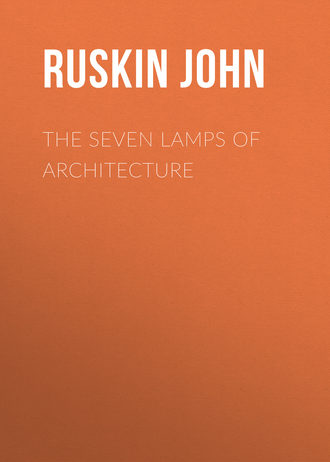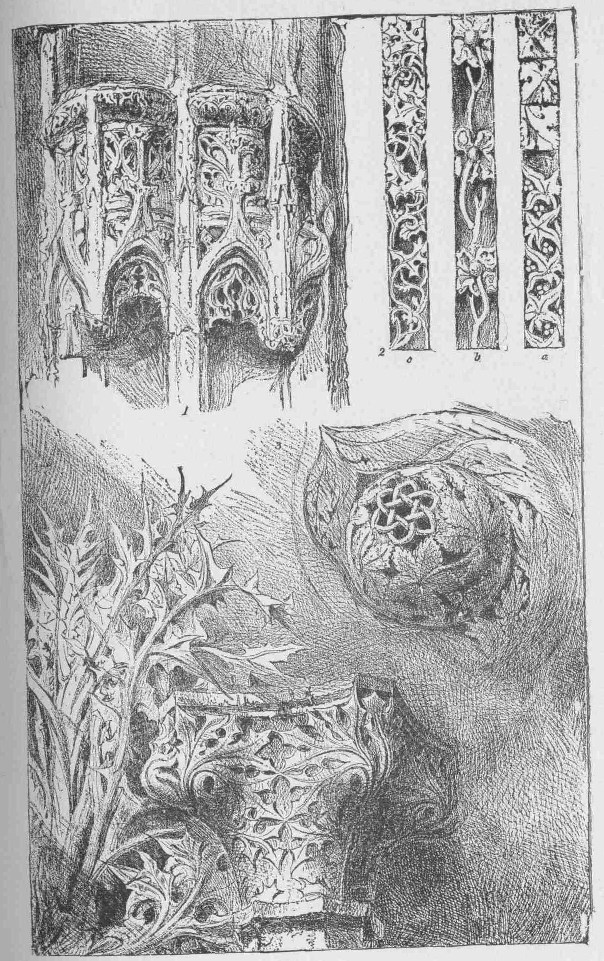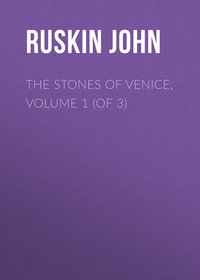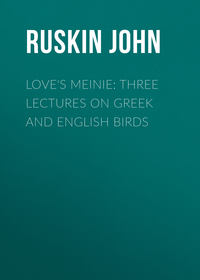 полная версия
полная версияThe Seven Lamps of Architecture
XII. Visibility, however, we must remember, depends, not only on situation, but on distance; and there is no way in which work is more painfully and unwisely lost than in its over delicacy on parts distant from the eye. Here, again, the principle of honesty must govern our treatment: we must not work any kind of ornament which is, perhaps, to cover the whole building (or at least to occur on all parts of it) delicately where it is near the eye, and rudely where it is removed from it. That is trickery and dishonesty. Consider, first, what kinds of ornaments will tell in the distance and what near, and so distribute them, keeping such as by their nature are delicate, down near the eye, and throwing the bold and rough kinds of work to the top; and if there be any kind which is to be both near and far off, take care that it be as boldly and rudely wrought where it is well seen as where it is distant, so that the spectator may know exactly what it is, and what it is worth. Thus chequered patterns, and in general such ornaments as common workmen can execute, may extend over the whole building; but bas-reliefs, and fine niches and capitals, should be kept down, and the common sense of this will always give a building dignity, even though there be some abruptness or awkwardness, in the resulting arrangements. Thus at San Zeno at Verona, the bas-reliefs, full of incident and interest are confined to a parallelogram of the front, reaching to the height of the capitals of the columns of the porch. Above these, we find a simple though most lovely, little arcade; and above that, only blank wall, with square face shafts. The whole effect is tenfold grander and better than if the entire façade had been covered with bad work, and may serve for an example of the way to place little where we cannot afford much. So, again, the transept gates of Rouen8 are covered with delicate bas-reliefs (of which I shall speak at greater length presently) up to about once and a half a man's height; and above that come the usual and more visible statues and niches. So in the campanile at Florence, the circuit of bas-reliefs is on its lowest story; above that come its statues; and above them all its pattern mosaic, and twisted columns, exquisitely finished, like all Italian work of the time, but still, in the eye of the Florentine, rough and commonplace by comparison with the bas-reliefs. So generally the most delicate niche work and best mouldings of the French Gothic are in gates and low windows well within sight; although, it being the very spirit of that style to trust to its exuberance for effect, there is occasionally a burst upwards and blossoming unrestrainably to the sky, as in the pediment of the west front of Rouen, and in the recess of the rose window behind it, where there are some most elaborate flower-mouldings, all but invisible from below, and only adding a general enrichment to the deep shadows that relieve the shafts of the advanced pediment. It is observable, however, that this very work is bad flamboyant, and has corrupt renaissance characters in its detail as well as use; while in the earlier and grander north and south gates, there is a very noble proportioning of the work to the distance, the niches and statues which crown the northern one, at a height of about one hundred feet from the ground, being alike colossal and simple; visibly so from below, so as to induce no deception, and yet honestly and well-finished above, and all that they are expected to be; the features very beautiful, full of expression, and as delicately wrought as any work of the period.
XIII. It is to be remembered, however, that while the ornaments in every fine ancient building, without exception so far as I am aware, are most delicate at the base, they are often in greater effective quantity on the upper parts. In high towers this is perfectly natural and right, the solidity of the foundation being as necessary as the division and penetration of the superstructure; hence the lighter work and richly pierced crowns of late Gothic towers. The campanile of Giotto at Florence, already alluded to, is an exquisite instance of the union of the two principles, delicate bas-reliefs adorning its massy foundation, while the open tracery of the upper windows attracts the eye by its slender intricacy, and a rich cornice crowns the whole. In such truly fine cases of this disposition the upper work is effective by its quantity and intricacy only, as the lower portions by delicacy; so also in the Tour de Beurre at Rouen, where, however, the detail is massy throughout, subdividing into rich meshes as it ascends. In the bodies of buildings the principle is less safe, but its discussion is not connected with our present subject.
XIV. Finally, work may be wasted by being too good for its material, or too fine to bear exposure; and this, generally a characteristic of late, especially of renaissance, work, is perhaps the worst fault of all. I do not know anything more painful or pitiful than the kind of ivory carving with which the Certosa of Pavia, and part of the Colleone sepulchral chapel at Bergamo, and other such buildings, are incrusted, of which it is not possible so much as to think without exhaustion; and a heavy sense of the misery it would be, to be forced to look at it at all. And this is not from the quantity of it, nor because it is bad work—much of it is inventive and able; but because it looks as if it were only fit to be put in inlaid cabinets and velveted caskets, and as if it could not bear one drifting shower or gnawing frost. We are afraid for it, anxious about it, and tormented by it; and we feel that a massy shaft and a bold shadow would be worth it all. Nevertheless, even in cases like these, much depends on the accomplishment of the great ends of decoration. If the ornament does its duty—if it is ornament, and its points of shade and light tell in the general effect, we shall not be offended by finding that the sculptor in his fulness of fancy has chosen to give much more than these mere points of light, and has composed them of groups of figures. But if the ornament does not answer its purpose, if it have no distant, no truly decorative power; if generally seen it be a mere incrustation and meaningless roughness, we shall only be chagrined by finding when we look close, that the incrustation has cost years of labor and has millions of figures and histories in it and would be the better of being seen through a Stanhope lens. Hence the greatness of the northern Gothic as contrasted with the latest Italian. It reaches nearly the same extreme of detail; but it never loses sight of its architectural purpose, never fails in its decorative power; not a leaflet in it but speaks, and speaks far off, too; and so long as this be the case, there is no limit to the luxuriance in which such work may legitimately and nobly be bestowed.

PLATE I.—(Page 33—Vol. V)
Ornaments from Rouen, St. Lo, and Venice.
XV. No limit: it is one of the affectations of architects to speak of overcharged ornament. Ornament cannot be overcharged if it be good, and is always overcharged when it is bad. I have given, on the opposite page (fig. 1), one of the smallest niches of the central gate of Rouen. That gate I suppose to be the most exquisite piece of pure flamboyant work existing; for though I have spoken of the upper portions, especially the receding window, as degenerate, the gate itself is of a purer period, and has hardly any renaissance taint. There are four strings of these niches (each with two figures beneath it) round the porch, from the ground to the top of the arch, with three intermediate rows of larger niches, far more elaborate; besides the six principal canopies of each outer pier. The total number of the subordinate niches alone, each worked like that in the plate, and each with a different pattern of traceries in each compartment, is one hundred and seventy-six.4 Yet in all this ornament there is not one cusp, one finial that is useless—not a stroke of the chisel is in vain; the grace and luxuriance of it all are visible—sensible rather—even to the uninquiring eye; and all its minuteness does not diminish the majesty, while it increases the mystery, of the noble and unbroken vault. It is not less the boast of some styles that they can bear ornament, than of others that they can do without it; but we do not often enough reflect that those very styles, of so haughty simplicity, owe part of their pleasurableness to contrast, and would be wearisome if universal. They are but the rests and monotones of the art; it is to its far happier, far higher, exaltation that we owe those fair fronts of variegated mosaic, charged with wild fancies and dark hosts of imagery, thicker and quainter than ever filled the depth of midsummer dream; those vaulted gates, trellised with close leaves; those window-labyrinths of twisted tracery and starry light; those misty masses of multitudinous pinnacle and diademed tower; the only witnesses, perhaps that remain to us of the faith and fear of nations. All else for which the builders sacrificed, has passed away—all their living interests, and aims, and achievements. We know not for what they labored, and we see no evidence of their reward. Victory, wealth, authority, happiness—all have departed, though bought by many a bitter sacrifice. But of them, and their life, and their toil upon the earth, one reward, one evidence, is left to us in those gray heaps of deep-wrought stone. They have taken with them to the grave their powers, their honors, and their errors; but they have left us their adoration.
CHAPTER II.
THE LAMP OF TRUTH
I. There is a marked likeness between the virtues of man and the enlightenment of the globe he inhabits—the same diminishing gradation in vigor up to the limits of their domains, the same essential separation from their contraries—the same twilight at the meeting of the two: a something wider belt than the line where the world rolls into night, that strange twilight of the virtues; that dusky debateable land, wherein zeal becomes impatience, and temperance becomes severity, and justice becomes cruelty, and faith superstition, and each and all vanish into gloom.
Nevertheless, with the greater number of them, though their dimness increases gradually, we may mark the moment of their sunset; and, happily, may turn the shadow back by the way by which it had gone down: but for one, the line of the horizon is irregular and undefined; and this, too, the very equator and girdle of them all—Truth; that only one of which there are no degrees, but breaks and rents continually; that pillar of the earth, yet a cloudy pillar; that golden and narrow line, which the very powers and virtues that lean upon it bend, which policy and prudence conceal, which kindness and courtesy modify, which courage overshadows with his shield, imagination covers with her wings, and charity dims with her tears. How difficult must the maintenance of that authority be, which, while it has to restrain the hostility of all the worst principles of man, has also to restrain the disorders of his best—which is continually assaulted by the one, and betrayed by the other, and which regards with the same severity the lightest and the boldest violations of its law! There are some faults slight in the sight of love, some errors slight in the estimate of wisdom; but truth forgives no insult, and endures no stain.
We do not enough consider this; nor enough dread the slight and continual occasions of offence against her. We are too much in the habit of looking at falsehood in its darkest associations, and through the color of its worst purposes. That indignation which we profess to feel at deceit absolute, is indeed only at deceit malicious. We resent calumny, hypocrisy and treachery, because they harm us, not because they are untrue. Take the detraction and the mischief from the untruth, and we are little offended by it; turn it into praise, and we may be pleased with it. And yet it is not calumny nor treachery that does the largest sum of mischief in the world; they are continually crushed, and are felt only in being conquered. But it is the glistening and softly spoken lie; the amiable fallacy; the patriotic lie of the historian, the provident lie of the politician, the zealous lie of the partizan, the merciful lie of the friend, and the careless lie of each man to himself, that cast that black mystery over humanity, through which any man who pierces, we thank as we would thank one who dug a well in a desert; happy in that the thirst for truth still remains with us, even when we have wilfully left the fountains of it.
It would be well if moralists less frequently confused the greatness of a sin with its unpardonableness. The two characters are altogether distinct. The greatness of a fault depends partly on the nature of the person against whom it is committed, partly upon the extent of its consequences. Its pardonableness depends, humanly speaking, on the degree of temptation to it. One class of circumstances determines the weight of the attaching punishment; the other, the claim to remission of punishment: and since it is not easy for men to estimate the relative weight, nor possible for them to know the relative consequences, of crime, it is usually wise in them to quit the care of such nice measurements, and to look to the other and clearer condition of culpability; esteeming those faults worst which are committed under least temptation. I do not mean to diminish the blame of the injurious and malicious sin, of the selfish and deliberate falsity; yet it seems to me, that the shortest way to check the darker forms of deceit is to set watch more scrupulous against those which have mingled, unregarded and unchastised, with the current of our life. Do not let us lie at all. Do not think of one falsity as harmless, and another as slight, and another as unintended. Cast them all aside: they may be light and accidental; but they are an ugly soot from the smoke of the pit, for all that; and it is better that our hearts should be swept clean of them, without over care as to which is largest or blackest. Speaking truth is like writing fair, and comes only by practice; it is less a matter of will than of habit, and I doubt if any occasion can be trivial which permits the practice and formation of such a habit. To speak and act truth with constancy and precision is nearly as difficult, and perhaps as meritorious, as to speak it under intimidation or penalty; and it is a strange thought how many men there are, as I trust, who would hold to it at the cost of fortune or life, for one who would hold to it at the cost of a little daily trouble. And seeing that of all sin there is, perhaps, no one more flatly opposite to the Almighty, no one more "wanting the good of virtue and of being," than this of lying, it is surely a strange insolence to fall into the foulness of it on light or on no temptation, and surely becoming an honorable man to resolve that, whatever semblances or fallacies the necessary course of his life may compel him to bear or to believe, none shall disturb the serenity of his voluntary actions, nor diminish the reality of his chosen delights.
II. If this be just and wise for truth's sake, much more is it necessary for the sake of the delights over which she has influence. For, as I advocated the expression of the Spirit of Sacrifice in the acts and pleasures of men, not as if thereby those acts could further the cause of religion, but because most assuredly they might therein be infinitely ennobled themselves, so I would have the Spirit or Lamp of Truth clear in the hearts of our artists and handicraftsmen, not as if the truthful practice of handicrafts could far advance the cause of truth, but because I would fain see the handicrafts themselves urged by the spurs of chivalry: and it is, indeed, marvellous to see what power and universality there is in this single principle, and how in the consulting or forgetting of it lies half the dignity or decline of every art and act of man. I have before endeavored to show its range and power in painting; and I believe a volume, instead of a chapter, might be written on its authority over all that is great in architecture. But I must be content with the force of instances few and familiar, believing that the occasions of its manifestation may be more easily discovered by a desire to be true, than embraced by an analysis of truth.
Only it is very necessary in the outset to mark clearly wherein consists the essence of fallacy as distinguished from supposition.
III. For it might be at first thought that the whole kingdom of imagination was one of deception also. Not so: the action of the imagination is a voluntary summoning of the conceptions of things absent or impossible; and the pleasure and nobility of the imagination partly consist in its knowledge and contemplation of them as such, i.e. in the knowledge of their actual absence or impossibility at the moment of their apparent presence or reality. When the imagination deceives it becomes madness. It is a noble faculty so long as it confesses its own ideality; when it ceases to confess this, it is insanity. All the difference lies in the fact of the confession, in there being no deception. It is necessary to our rank as spiritual creatures, that we should be able to invent and to behold what is not; and to our rank as moral creatures that we should know and confess at the same time that it is not.
IV. Again, it might be thought, and has been thought, that the whole art of painting is nothing else than an endeavor to deceive. Not so: it is, on the contrary, a statement of certain facts, in the clearest possible way. For instance: I desire to give an account of a mountain or of a rock; I begin by telling its shape. But words will not do this distinctly, and I draw its shape, and say, "This was its shape." Next: I would fain represent its color; but words will not do this either, and I dye the paper, and say, "This was its color." Such a process may be carried on until the scene appears to exist, and a high pleasure may be taken in its apparent existence. This is a communicated act of imagination, but no lie. The lie can consist only in an assertion of its existence (which is never for one instant made, implied, or believed), or else in false statements of forms and colors (which are, indeed, made and believed to our great loss, continually). And observe, also, that so degrading a thing is deception in even the approach and appearance of it, that all painting which even reaches the mark of apparent realization, is degraded in so doing. I have enough insisted on this point in another place.
V. The violations of truth, which dishonor poetry and painting, are thus for the most part confined to the treatment of their subjects. But in architecture another and a less subtle, more contemptible, violation of truth is possible; a direct falsity of assertion respecting the nature of material, or the quantity of labor. And this is, in the full sense of the word, wrong; it is as truly deserving of reprobation as any other moral delinquency; it is unworthy alike of architects and of nations; and it has been a sign, wherever it has widely and with toleration existed, of a singular debasement of the arts; that it is not a sign of worse than this, of a general want of severe probity, can be accounted for only by our knowledge of the strange separation which has for some centuries existed between the arts and all other subjects of human intellect, as matters of conscience. This withdrawal of conscientiousness from among the faculties concerned with art, while it has destroyed the arts themselves, has also rendered in a measure nugatory the evidence which otherwise they might have presented respecting the character of the respective nations among whom they have been cultivated; otherwise, it might appear more than strange that a nation so distinguished for its general uprightness and faith as the English, should admit in their architecture more of pretence, concealment, and deceit, than any other of this or of past time.
They are admitted in thoughtlessness, but with fatal effect upon the art in which they are practised. If there were no other causes for the failures which of late have marked every great occasion for architectural exertion, these petty dishonesties would be enough to account for all. It is the first step and not the least, towards greatness to do away with these; the first, because so evidently and easily in our power. We may not be able to command good, or beautiful, or inventive architecture; but we can command an honest architecture: the meagreness of poverty may be pardoned, the sternness of utility respected; but what is there but scorn for the meanness of deception?
VI. Architectural Deceits are broadly to be considered under three heads:—
1st. The suggestion of a mode of structure or support, other than the true one; as in pendants of late Gothic roofs.
2d. The painting of surfaces to represent some other material than that of which they actually consist (as in the marbling of wood), or the deceptive representation of sculptured ornament upon them.
3d. The use of cast or machine-made ornaments of any kind.
Now, it may be broadly stated, that architecture will be noble exactly in the degree in which all these false expedients are avoided. Nevertheless, there are certain degrees of them, which, owing to their frequent usage, or to other causes, have so far lost the nature of deceit as to be admissible; as, for instance, gilding, which is in architecture no deceit, because it is therein not understood for gold; while in jewellery it is a deceit, because it is so understood, and therefore altogether to be reprehended. So that there arise, in the application of the strict rules of right, many exceptions and niceties of conscience; which let us as briefly as possible examine.
VII. 1st. Structural Deceits. I have limited these to the determined and purposed suggestion of a mode of support other than the true one. The architect is not bound to exhibit structure; nor are we to complain of him for concealing it, any more than we should regret that the outer surfaces of the human frame conceal much of its anatomy; nevertheless, that building will generally be the noblest, which to an intelligent eye discovers the great secrets of its structure, as an animal form does, although from a careless observer they may be concealed. In the vaulting of a Gothic roof it is no deceit to throw the strength into the ribs of it, and make the intermediate vault a mere shell. Such a structure would be presumed by an intelligent observer, the first time he saw such a roof; and the beauty of its traceries would be enhanced to him if they confessed and followed the lines of its main strength. If, however, the intermediate shell were made of wood instead of stone, and whitewashed to look like the rest,—this would, of course, be direct deceit, and altogether unpardonable.
There is, however, a certain deception necessarily occurring in Gothic architecture, which relates, not to the points, but to the manner, of support. The resemblance in its shafts and ribs to the external relations of stems and branches, which has been the ground of so much foolish speculation, necessarily induces in the mind of the spectator a sense or belief of a correspondent internal structure; that is to say, of a fibrous and continuous strength from the root into the limbs, and an elasticity communicated upwards, sufficient for the support of the ramified portions. The idea of the real conditions, of a great weight of ceiling thrown upon certain narrow, jointed lines, which have a tendency partly to be crushed, and partly to separate and be pushed outwards, is with difficulty received; and the more so when the pillars would be, if unassisted, too slight for the weight, and are supported by external flying buttresses, as in the apse of Beauvais, and other such achievements of the bolder Gothic. Now, there is a nice question of conscience in this, which we shall hardly settle but by considering that, when the mind is informed beyond the possibility of mistake as to the true nature of things, the affecting it with a contrary impression, however distinct, is no dishonesty, but on the contrary, a legitimate appeal to the imagination. For instance, the greater part of the happiness which we have in contemplating clouds, results from the impression of their having massive, luminous, warm, and mountain-like surfaces; and our delight in the sky frequently depends upon our considering it as a blue vault. But we know the contrary, in both instances; we know the cloud to be a damp fog, or a drift of snow flakes; and the sky to be a lightless abyss. There is, therefore, no dishonesty, while there is much delight, in the irresistibly contrary impression. In the same way, so long as we see the stones and joints, and are not deceived as to the points of support in any piece of architecture, we may rather praise than regret the dextrous artifices which compel us to feel as if there were fibre in its shafts and life in its branches. Nor is even the concealment of the support of the external buttress reprehensible, so long as the pillars are not sensibly inadequate to their duty. For the weight of a roof is a circumstance of which the spectator generally has no idea, and the provisions for it, consequently, circumstances whose necessity or adaptation he could not understand. It is no deceit, therefore, when the weight to be borne is necessarily unknown, to conceal also the means of bearing it, leaving only to be perceived so much of the support as is indeed adequate to the weight supposed. For the shafts do, indeed, bear as much as they are ever imagined to bear, and the system of added support is no more, as a matter of conscience, to be exhibited, than, in the human or any other form, mechanical provisions for those functions which are themselves unperceived.











